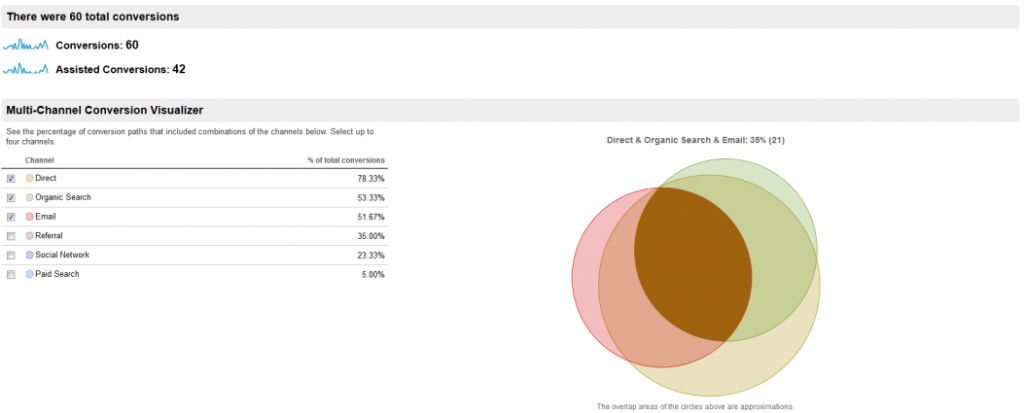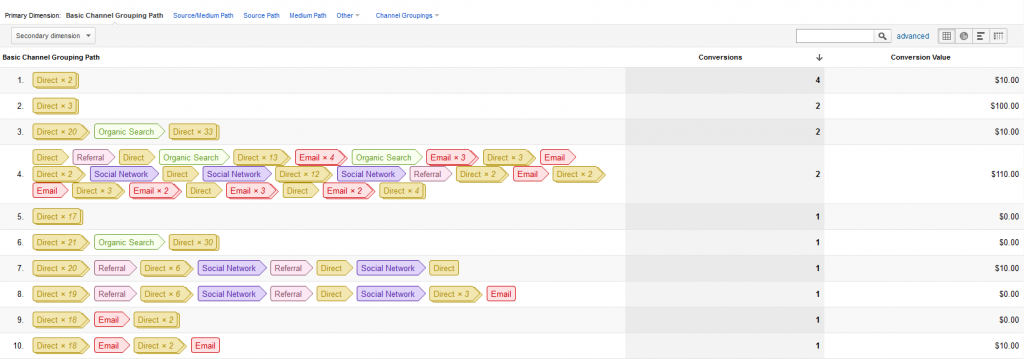Last month we discussed how multi-attribution can improve your college’s marketing measurability and help periodic evaluation of your marketing efforts and strategies.
View Part 1: Multi-Attribution Modeling
In the second part, we will talk about multi-channel attribution using Google Analytics. Google introduced multi-channel attribution to all analytics users in September 2011. Previously it was available to premium account holders only.
Before we dive too deeply into multi-channel attribution reporting, let’s discuss a few of the key channel attribution elements:
Acquisition Channels: Also known as channels or touch points, acquisition channels are the source of traffic to your college’s web properties. E.g. Organic search, affiliates, paid advertisements, etc.
Channel Grouping: In multi-channel attribution reports, channel grouping is the set of channel labels. Google Analytics offers two types of channel grouping:
- Basic Channel Grouping: This is the set of predefined channel labels. Google Analytics defines following channel labels as part of basic channel grouping:
Display, paid search, organic search, social, referral, email, direct and other advertisement.
- Custom Channel Grouping: This is user defined channel grouping. You can create as many channel groupings as you want – there is no limit. To create your channel grouping you can copy the basic channel grouping to get started or create your new channel grouping from scratch.

Fig.1: Channel Grouping
Conversions: In multi-attribution funnel reports, Google defines conversions as the sum of number of conversions and number of e-commerce transactions (if enabled).
For example: If 18 visitors filled out your college’s application form online and 42 students paid tuition fees via e-commerce transactions, the multi-channel funnel report will show 60 conversions whereas other Google Analytics reports will show 18 goal conversions and 42 e-commerce transactions.

Fig.2: Conversions
Conversion Path: This is the sequence of interactions between visitor and acquisition channels that lead to conversion. Google Analytics records conversion paths via visitor cookies (_utma).
For example: If a prospective student first visits your college’s program page from a Google PPC campaign, then returns as an organic search visitor, identifies a program of interest, leaves to search for program reviews and later comes back through some review board to eventually complete the conversion, the multi-channel funnel report will show the following conversion path:

Fig.3: Conversion Path
Interaction: Also known as touch, this is an exposure to the acquisition channels. E.g. In the above conversion path, each exposure will be recorded as an interaction in multi-channel funnel reports. In a conversion path, channels can play three roles:
First Interaction: First referral (or initiator) on the conversion path.
Assist Interaction: Any non-last referral on the conversion path.
Last Interaction: Immediately preceding the conversion referral.
In the above mentioned example, the multi-channel funnel report will show “Paid Search” as the first interaction, “Organic Search” as an assist interaction and “Referral” as the last interaction.
Assisted Conversions: These reports for a given marketing channel analyze all interactions other than the last one that lead to a conversion.
Get started with Multi-Channel Attribution in Google Analytics
- Ensure your college’s marketing efforts are measurable. E.g. Analytics code on landing pages, campaign link tagging, etc.
- Ensure you have a clear “Call-to-Action” and a clear vision of your audience’s interaction and behavior on your web properties.
- Ensure conversion goals and e-commerce tracking (if applicable) are configured.
Once you have all of the above in place, launch your campaign and wait for a couple of days for data to be collected. Multi-channel funnels in Google Analytics can be located under Standard Reporting > Conversions > Multi-Channel Funnels
Google offers five types of multi-channel reports:
- Overview Report: This represents how various acquisition channels work together to create conversion. Out of the box, it will show you which campaign and acquisition channels are driving your desired results (also known as “upper funnel channels”, because they often result in a visitor’s first exposure to your college’s web ecosystem in the longer path of conversion). The interaction of channels can be visualized with a Venn diagram, where the overlapping area represents the degree to which visitors were exposed to all the intersecting channels and the size of each circle represents the volume of conversions coming through that acquisition channel.

Fig.4:Overview Report
- Assisted Conversion Report: This report displays the number of conversions for which each non-last marketing channel appears on the conversion path.

Fig.5: Assist Conversion Report
- Top Conversion Path Report: This report can help your marketing team understand how channels interact along a conversion path, and how long it takes visitors to convert. This report summarizes all the unique conversion paths that lead to conversion.

Fig.6: Top Conversion path
- Time Lag Report: This report can help you analyze how many days it takes visitors to convert (within a 30 day period).

Fig.7: Time lag report
- Path Length Report: This displays how many interactions it took for a visitor to convert.

Fig.8: Path Length Report
Through multi-channel reports your college can determine:
- How various acquisition channels work together to create a conversion
- How much time a visitor takes before converting into a lead
- What role did prior touch points play in a conversion
- How to attribute conversion to an acquisition channel

It is common to experience data discrepancy between multi-channel funnel reports and other Google Analytics reports due to the following reasons:
- Multi-channel funnel data lags up to 48 hours
- In other Google Analytics reports conversion is equivalent to goal conversion (e-commerce transactions are mentioned separately whereas in multi-channel funnel reports conversion is calculated as the sum of goal conversions and e-commerce-transactions)
The last decade has experienced a remarkable proliferation of marketing channels, strategies and technologies. Marketers and analysts are challenged to stay on top of the emerging opportunities. Attribution is not an exception to this pattern; it’s one of the solutions to enhance accountability of marketing efforts. Attribution, if done properly and across silos and touch points, can finally fill in the gap for analysts and answer the question of what is working and how.
How do you plan to use Google Analytics multi-channel attribution to gain better insights into your college’s marketing efforts? Share your ideas and comments!










